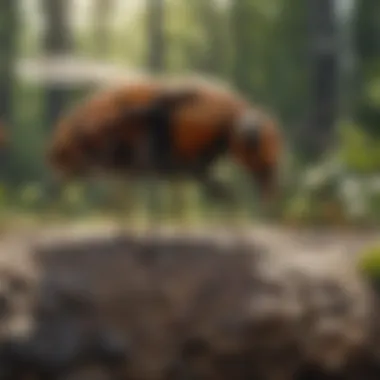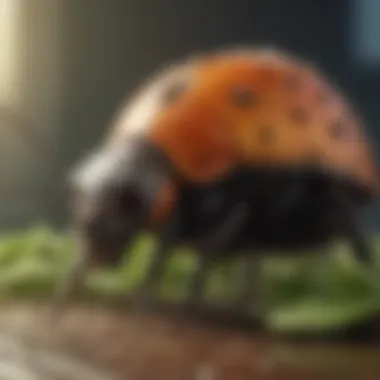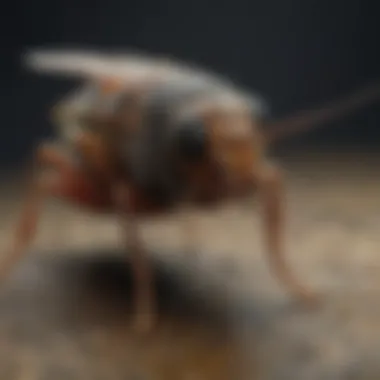EcoExempt Solutions: Green Pest Management Insights


Intro
Pest management remains a significant concern for homeowners and professionals alike. Using EcoExempt solutions presents an effective way to tackle this issue while minimizing environmental impact. Understanding the nature of pests is the foundation for any management approach. This article will delve into the core elements of intelligent pest management crafted around ecological practices, offering insights into identification, prevention, and control methods.
Understanding the Pest
A profound knowledge of pests is essential for effective pest management. This section will explore two critical aspects: Identification and Life Cycle.
Identification
Identifying the pest correctly is critical in deciding the most effective management approach. Different species require distinct control measures. Common household pests include ants, termites, cockroaches, and rodents. Each has its unique traits, behaviors, and infestation signs. For example, ants tend to leave a pheromone trail, while cockroaches can often be found in dark, damp areas. Understanding these identifiers allows homeowners to respond promptly and effectively.
Life Cycle
Understanding the life cycle of pests is equally important. Most pests go through several developmental stages: egg, larva, pupa, and adult. Recognizing these stages can help tailor control strategies to the specific life phase of the pest. For instance, targeting larvae may be more effective than treating adults in certain situations.
"Knowledge of a pest's life cycle allows for a more targeted and efficient management plan."
The ability to match control strategies with life cycle stages fosters a more eco-conscious approach by reducing the need for harsh chemicals.
Pest Prevention Strategies
Proactive measures in pest management can significantly reduce infestation risks. Here, we will discuss Environment Modification and Physical Barriers.
Environment Modification
Modifying the environment can deter pests by making the habitat less appealing to them. Factors to consider include:
- Moisture control. Unkempt gardens and overwatering attract pests.
- Food storage. Ensuring food is sealed and stored properly minimizes pest attraction.
- Waste management. Regular disposal of trash prevents pests from finding shelter and food.
Physical Barriers
Physical barriers are another effective method for keeping pests at bay. Common barriers include screens for windows, sealing holes in structures, and using traps. These methods reduce the chances of pests entering the home while adhering to eco-friendly principles.
Control Methods
When prevention fails, control methods become necessary. This section will tackle Chemical Control and Biological Control options.
Chemical Control
While eco-friendly solutions often prioritize avoiding chemicals, there might be occasions when they are needed. However, choosing softer alternatives can align better with sustainable practices. Products that utilize natural ingredients can be effective without harsh consequences on the environment. Always ensure that any chemicals used are labeled as safe for indoor use, particularly around pets or children.
Biological Control
Biological control involves leveraging natural predators to manage pests. Introducing beneficial insects, like ladybugs or lacewings, can reduce pest populations without the need for synthetic chemicals. Encouraging a natural ecosystem in your garden not only aids in controlling pests but also enhances biodiversity.
This comprehensive look into EcoExempt pest management enables homeowners to make informed choices. By understanding pests and implementing sustainable strategies, a pest-free environment can be achieved while promoting ecological health.
Understanding EcoExempt
In the face of increasing environmental concerns, eco-friendly pest management has become crucial. EcoExempt solutions offer a method that balances effectiveness with ecological responsibility. This section will explore the significance of this approach to pest control and why it’s essential for both homeowners and professionals.
Definition and Principles


EcoExempt refers to pest management strategies that prioritize the environment while addressing pest issues. The main principle is to minimize the ecological footprint by using methods that are safer for humans and wildlife. This can include various techniques such as Integrated Pest Management (IPM), biological control, and the use of natural deterrennts. These practices aim to reduce reliance on chemical pesticides, promoting sustainability.
Key principles of EcoExempt solutions include:
- Sustainability: Using practices that can be maintained without harming the environment.
- Prevention: Focusing on prevention rather than reactive measures can help avoid pest infestations.
- Education: Informing homeowners about the impacts of pest management choices.
Historical Context
The concept of EcoExempt pest management emerged as a response to the adverse effects of traditional pesticide use. In the mid-20th century, chemical pesticides like DDT became widely used, leading to significant ecological damage and health issues in humans and pets. As awareness grew, so did interest in alternative pest control methods. In the 1990s, Integrated Pest Management began to gain traction, promoting more sustainable practices.
This historical transition reflects a broader change in society's attitudes toward the environment and health. As environmentally-friendly practices became more popular, various certifications and standards emerged, enabling consumers to identify and choose eco-sensitive pest management solutions.
Current Trends in Pest Management
Today, the field of pest management is continually evolving. The emergence of digital platforms has transformed how pest issues are handled. Homeowners can now access immediate resources, expertise, and products that align with EcoExempt principles.
There is also a noticeable shift toward using biological control agents, such as beneficial insects, which effectively reduce pest populations without compromising ecosystem health. Other noteworthy trends include:
- Smart Technology: Use of sensors and IoT devices to monitor pest activity in real-time.
- Public Awareness: Increased consumer demand for eco-friendly products and services.
- Regulations: Stricter laws on chemical pesticide use.
"The future of pest management is firmly rooted in sustainability. Understanding and implementing EcoExempt solutions will enhance effectiveness while preserving the environment."
These advancements indicate a promising move towards more sustainable pest control practices, paving the way for widespread adoption of EcoExempt strategies.
Key Components of EcoExempt Strategies
The realm of pest management is evolving, embracing more environmentally conscious methods that favor long-term ecological balance. The Key Components of EcoExempt Strategies serve as the foundation for creating effective and sustainable practices. Understanding these core elements is crucial for homeowners eager to address pest issues without relying heavily on synthetic chemicals.
A well-rounded pest control strategy must integrate various approaches. This includes understanding the lifecycle and behavior of pests, utilizing natural resources, and fostering a habitat that encourages beneficial organisms. The benefits of adopting these strategies go beyond pest reduction; they enhance soil health and support biodiversity, contributing to a thriving ecosystem in residential settings.
Integrated Pest Management
Integrated Pest Management (IPM) is a holistic approach that combines multiple strategies for effective pest control. It emphasizes prevention, monitoring, and control techniques tailored to specific pests and their environment. IPM strategies prioritize understanding the ecological relationships within the home and garden. By assessing the situation, homeowners can determine when intervention is necessary and select methods that minimize harm to non-target species.
- Prevention: Always the first line of defense, prevention techniques reduce the likelihood of pest infestations. This might include proper sanitation, sealing potential entry points, and selecting pest-resistant plants for landscaping.
- Monitoring: Regular observations enable homeowners to identify pest populations before they reach critical levels. Tools like sticky traps or simple visual inspections are invaluable for determining the extent of the problem.
- Control: If intervention is needed, IPM advocates for the use of eco-friendly methods first. This can be chemical controls that have minimal impact or biological controls employing natural predators.
Natural Deterrents and Barriers
Natural deterrents and barriers are cornerstones of EcoExempt practices. They serve as physical and chemical barriers against pests, reducing reliance on more toxic options. These methods can be easy to implement and vary in effectiveness depending on specific pest pressures.
Some common natural deterrents include:
- Essential oils: Oils like peppermint and neem can repel insects due to their strong scents and properties.
- Cayenne pepper or garlic: Sprays made from these ingredients work well as repellent solutions for various pests.
- Physical barriers: Screens, row covers, and nets can keep pests away from vulnerable plants or home areas.
Homeowners can create barriers by planting certain crops that naturally ward off pests, like marigolds, which deter nematodes and aphids. Incorporating such practices fosters a balanced environment while mitigating pest issues.
Biological Control Agents
Biological control agents play a significant role in EcoExempt strategies by utilizing natural predators or pathogens to manage pest populations. This method is not only effective but also aligns with sustainable practices.
- Beneficial insects: Many insects, such as ladybugs and lacewings, feed on common garden pests like aphids and thrips. Introducing these beneficial species can help maintain a healthy balance within the garden ecosystem.
- Nematodes: Beneficial nematodes are microscopic worms that seek out and destroy harmful larvae in the soil, offering an effective underground solution to pest problems without chemicals.
- Fungi and bacteria: Certain strains of beneficial microbes can infect and kill pest insects, further minimizing their impact on plants. These options enhance soil health while keeping pest populations in check.
In summary, the Key Components of EcoExempt Strategies provide a robust framework for homeowners seeking sustainable pest management solutions. By integrating IPM, utilizing natural deterrents, and employing biological control agents, it is possible to achieve a balanced approach that protects both the environment and the home.
The Role of Beneficial Insects


Beneficial insects are a vital part of EcoExempt pest management. They contribute significantly to controlling pest populations without harmful chemicals. Understanding their role can help homeowners make informed decisions that support both their gardens and the environment.
These insects naturally prey on or parasitize pests that damage crops and gardens. By introducing or encouraging these beneficial insects, one can minimize pest outbreaks effectively. Relying on these natural allies promotes a balanced ecosystem and aligns with eco-friendly practices.
Types of Beneficial Insects
Beneficial insects are diverse, and each type plays a unique role in pest management. Some of the common categories include:
- Predatory Insects: These insects hunt down their prey. For example, ladybugs feed on aphids, which can damage plants.
- Parasitic Insects: These insects lay their eggs inside or on the host organism. The resulting larvae consume the host, effectively controlling pest populations. Wasps, for instance, are known for their parasitic behavior on caterpillars.
- Pollinators: While not directly involved in pest control, pollinators like bees support healthy plant growth, making plants more resilient to pests.
- Detritivores: These insects, including certain beetles, help decompose organic material, thus enriching the soil and promoting plant health.
How to Attract Beneficial Insects
Attracting beneficial insects to your garden can be achieved with some thoughtful strategies. Here are a few effective methods:
- Plant Diversity: Incorporate a variety of plants, especially flowers that attract beneficial insects. Marigolds, dill, and yarrow are great options.
- Provide Shelter: Create habitats with native plants, ground cover, and mulching to offer shelter for beneficial insects.
- Avoid Pesticides: Steering clear of toxic chemicals will prevent harming the beneficial insect populations.
- Water Sources: Establish shallow water sources where these insects can hydrate without drowning.
Case Studies of Beneficial Insects in Action
Numerous case studies illustrate the successful implementation of beneficial insects in pest control. For instance:
- In California, growers introduced ladybugs to control aphid populations. The outcome was a significant reduction in the need for chemical pesticides while maintaining crop yield.
- In organic strawberry farms, parasitic wasps were utilized to manage spider mite infestations. This approach decreased overall pesticide use and maintained healthy strawberry production.
"Utilizing beneficial insects is not just a practice, it is a philosophy of sustainable gardening."
These examples demonstrate the effectiveness of using beneficial insects in pest management. By studying these practices, homeowners can effectively sustain their garden health while minimizing environmental impact. Implementing these strategies is not only eco-friendly but also cost-effective in the long run.
EcoExempt Homeowner Solutions
EcoExempt homeowner solutions are crucial for individuals looking to maintain pest-free environments while adhering to sustainable practices. These solutions not only minimize the impact on the ecosystem but also promote health and safety within households. By embracing eco-friendly methods, homeowners can effectively address pest issues without harming beneficial organisms or polluting their surroundings. Understanding these practices is essential because they empower individuals to take control of their living spaces, making informed decisions that align with environmental stewardship.
DIY Pest Control Techniques
Do-it-yourself pest control can be an effective and sustainable approach. Homeowners can utilize various natural ingredients to create repellents and deterrents. Common household items such as vinegar, baking soda, and essential oils can serve this purpose.
- Vinegar solution: Mix equal parts of vinegar and water in a spray bottle. This solution repels ants and other pests.
- Baking soda trap: Combine baking soda with sugar. The sugar attracts pests, while the baking soda acts as a poison.
- Essential oils: Oils like peppermint, tea tree, and lavender can deter insects. Combine a few drops with water in a spray bottle and apply around entry points.
These methods reduce reliance on chemical pesticides and offer a low-cost solution for pest management.
Creating an Eco-Friendly Environment
An eco-friendly environment is key to preventing pest infestations. Homeowners can implement several strategies to enhance their living spaces.
- Maintain cleanliness: Regular cleaning removes food particles and potential breeding grounds for pests.
- Seal entry points: Inspect windows, doors, and walls for cracks or openings. Sealing these areas can prevent pests from entering.
- Use native plants: Incorporating native plants into your landscaping can attract beneficial insects and naturally deter pests.
- Manage moisture: Moisture attracts pests. Fix leaks and ensure proper drainage around the property.
By creating an environmentally conscious space, homeowners can effectively discourage unwanted pests.
Seasonal Considerations for Pest Management
Seasonal changes significantly influence pest behavior. Understanding these shifts allows homeowners to adjust their pest management strategies accordingly. Different pests may emerge during various seasons, and being proactive is essential.
- Spring: Begin inspections around the home. Look for signs of overwintering pests as temperatures rise.
- Summer: This is peak season for many pests. Regular monitoring and prevention practices such as mowing the lawn and trimming bushes can help.
- Fall: Pests often seek shelter as temperatures drop. Check and seal potential entry points to minimize infestations.
- Winter: While many pests go dormant, surveillance for entry points is important. Keep an eye on any signs inside the home.
Being aware of these seasonal patterns helps homeowners implement effective strategies to combat pests before they become significant issues.
Challenges in EcoExempt Practices


EcoExempt practices in pest management offer numerous advantages, but they come with their own set of challenges that need to be addressed. Understanding these challenges is paramount for homeowners seeking effective solutions that balance eco-friendliness with efficacy. This section delves into the specific obstacles faced and emphasizes the importance of navigating them to realize the full potential of EcoExempt initiatives.
Identifying Pests Accurately
The core of any effective pest management strategy lies in accurately identifying the pests involved. Misidentification can lead to inappropriate treatment methods, which may harm non-target species and potentially exacerbate the pest issue. Accurate identification helps in selecting the right EcoExempt methods tailored for specific pests. Key aspects of this challenge include:
- Knowledge Gaps: Many homeowners lack the expertise to identify pests accurately, leading to reliance on vague descriptions or images.
- Resources: Limited access to reliable pest identification resources can complicate the process. Digital tools or local extension services may provide assistance, but they are not always utilized.
- Changing Ecosystems: Environmental conditions continuously evolve. New pest species may emerge while others may become less active, further complicating identification efforts.
Ultimately, investing in education and resources is crucial for overcoming this challenge.
Balancing Eco-Friendly Methods with Effectiveness
Finding the right balance between environmentally friendly methods and effective pest control is a significant concern. Homeowners often desire to maintain a green approach while ensuring that pest problems do not compromise their living space. Some of the challenges include:
- Performance Metrics: EcoExempt solutions may not always yield immediate results like traditional pesticides. It takes time for natural methods to show effectiveness, which can be frustrating for homeowners dealing with persistent pest issues.
- Perceived Limitations: Some may mistakenly view EcoExempt methods as inadequate compared to chemical treatments, leading to skepticism about their effectiveness. This perception can hinder the widespread acceptance of eco-friendly pest management techniques.
- Integrated Approaches: Striking a balance often necessitates combining different strategies. However, determining the right integration of methods requires a thorough understanding of pests and the specific context of pest management.
To successfully navigate these challenges, continued discussion and research into eco-friendly practices are paramount for both consumers and industry professionals.
Preventing Pest Resistance
Another critical challenge surrounding EcoExempt practices is the potential for pest resistance. Just as conventional pesticides can lead to resistance, EcoExempt methods are not immune. Addressing this challenge is essential for sustainable pest control. Some key elements include:
- Biodiversity Importance: Maintaining a diverse ecosystem mitigates the chances of pests developing resistance. EcoExempt strategies should focus on fostering varied habitats to support natural predators and beneficial insects that manage pest populations.
- Rotation of Methods: Like antibiotics in medicine, rotating pest control strategies can help prevent pests from adapting to specific methods. Employing a diverse range of EcoExempt solutions is vital to maintaining effectiveness.
- Education and Awareness: Homeowners must be educated about the risks of resistance and encouraged to adopt a multifaceted approach to pest management, involving both EcoExempt and traditional methods where appropriate.
By understanding these challenges, homeowners can take a proactive stance in their pest management efforts. A sound strategy that incorporates education, ongoing research, and community support will foster the effective implementation of EcoExempt solutions.
Regulatory and Certification Aspects
The significance of regulatory and certification aspects in pest management cannot be misestimated. These factors serve as the backbone for ensuring that eco-friendly pest management practices are not only effective but also adhere to established environmental protocols. Homeowners benefit from understanding these elements as they navigate through various EcoExempt solutions. The clarity provided by eco-certifications helps in making informed decisions about pest control methods, ensuring safety for both individuals and the surrounding ecosystem.
Understanding EcoCertifications
EcoCertifications play a crucial role in guiding consumers towards environmentally responsible choices in pest management. These certifications often involve third-party evaluations that assess the compliance of a product or service with specific environmental standards.
Some recognized eco-certifications include:
- Organic: Products that comply with organic farming standards, prohibiting harmful pesticides.
- Green Seal: A certification for products that meet rigorous environmental criteria.
- EPA Safer Choice: Products bearing this label are verified to have safer chemical ingredients.
By selecting products with these certifications, homeowners can ensure that their pest management strategies contribute positively to the environment. They can reduce harm to non-target organisms and minimize chemical runoff, aligning pest control with sustainable practices.
Compliance with Environmental Regulations
Compliance with environmental regulations is essential for maintaining ecological balance. Regulations are designed to protect public health, wildlife, and the environment from harmful chemicals and practices. By adhering to these standards, pest management practitioners ensure that their methods are not only compliant but also safe for residential areas.
Some key regulations affecting eco-friendly pest management include:
- Federal Insecticide, Fungicide, and Rodenticide Act (FIFRA): Governs the registration and use of pesticides.
- Clean Water Act: Aims to protect water quality and minimize pollution from pesticide runoff.
- Resource Conservation and Recovery Act (RCRA): Regulates hazardous waste management, including pesticides.
Understanding these regulations helps homeowners and pest management professionals avoid practices that could lead to legal penalties or environmental damage. It also fosters a sense of trust, as stakeholders can feel confident that methods used are legitimate and effective.
Impact of EcoExempt Practices on the Market
The rise of ecoExempt solutions is reshaping the pest management industry. As more consumers demand sustainable options, businesses are adapting accordingly. Eco-friendly practices not only satisfy a growing market but also offer various benefits, including differentiation from competitors.
The impact can be observed through:
- Market Growth: The eco-friendly pest control market is expanding rapidly, reflecting consumer preference for sustainable solutions.
- Innovation: Companies are investing in research and development to create effective eco-exempt products, pushing boundaries in pest control.
- Cost Efficiency: Not all eco-friendly solutions require high upfront investments; many DIY methods present cost-effective alternatives without compromising efficiency.
"Adopting ecoExempt practices not only meets consumer demand but also enhances a company's reputation as a responsible entity in the industry."
Overall, the convergence of regulatory frameworks and eco-certifications solidifies the foundation of eco-friendly pest management. Understanding these aspects empowers homeowners to make more informed choices regarding pest control methods, contributing to a healthier environment.







